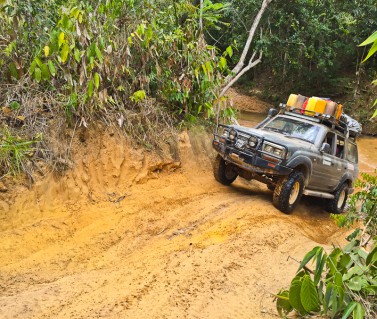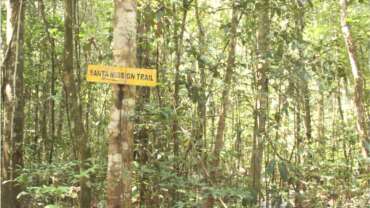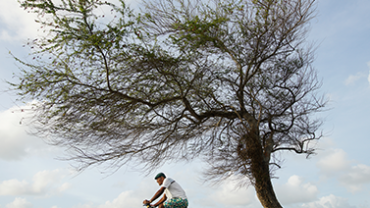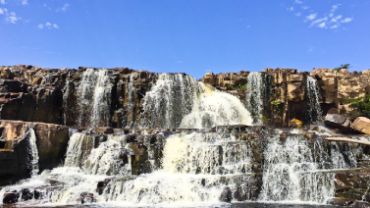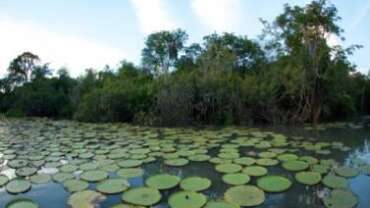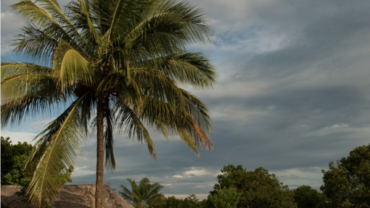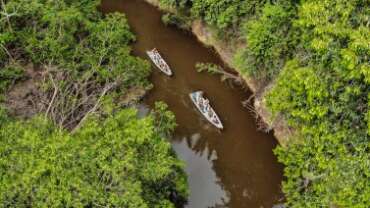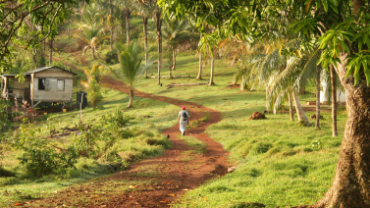Mountains & Rainforests of Guyana
Guyana is blessed with an extraordinary topography dominated by lush rainforests and four major mountain ranges. In between, sinuous rivers tumble down mountains and through the thick towering trees of sublime rainforest on long journeys towards the Amazon and Atlantic. With a wide range of ecosystems compressed into a relatively short distance, these mountainous landscapes are perfect hideaways for diverse wildlife for nature lovers and adventurous travellers to explore. This pristine and often remote topography is home to Indigenous Peoples living at the base of the mountains and in hilltop villages. The local villages and unique avian and wildlife are best explored on foot or by 4×4 safari.
Pakaraima Mountain Range
The Pakaraima Mountain Range on the western edge of Guyana, extending for 400 kilometres, is home to the famous Mount Roraima and is where thrill-seekers head to maneuver their 4×4 vehicles over week-long safaris. This mountain range offers some of the most adventurous experiences in Guyana. Here, you can stay at remote hilltop villages for the night or hang your hammock in places that have a ‘middle of nowhere’ appeal. Wildlife and birding enthusiasts visit for reasons that are more sedate. The untouched folds of these mountains have the highest level of plant endemism in Guyana and are home to some of the grandest waterfalls in the country.
Exploring Pakaraimas on the 4X4
Combine your love for off road travel with rough terrain and you get ‘real adventure’! The annual Pakaraima Mountain Safari is an 8-day self-drive through the Pakaraimas, covering far-flung villages and challenging 4×4 terrain through deep-set forests and vast open savannahs. See what the indigenous lifestyle is like in remote villages that host you along the way. After a hard day on the 4×4 trail and a hearty meal, hang your hammock and fall asleep gazing at the star-filled skies. Dip your feet in the Orinduik Falls for a cool relaxing break as one of many highlights. It is your chance to meet like-minded adventure enthusiasts, as everyone meanders from Georgetown to Lethem, just in time for the Rupununi Rodeo.
Village Life
The abundance resources of the Pakaraimas have attracted Indigenous Peoples for millennia. Visiting them is a wonderful way to experience their legendary hospitality in the most remote corners of Guyana. Many of the communities in the mountains offer basic lodging, meals, and sell local handicrafts that you can take back as souvenirs. Staying in these villages directly benefits community tourism efforts and provides access to some of the best and most rewarding cultural experiences in the country.
Wildlife in the Pakaraimas
The varied elevations and ecosystems from the grasslands and rainforests to the mountaintops, along with waterfall-laden creeks, offer a great home for wildlife. Close encounters with small mammals and giant species are not uncommon when you are traversing through the dense forested mountains and valleys. Jaguars, anteaters, labbas and tapirs are commonly found in the Pakaraimas. Mammals and birds may be elusive at first, but patiently waiting in the right spots in the company of a local guide will often result in spotting them, especially during dawn and dusk. The Pakaraima Mountain Inn is the perfect retreat for those who want to stay and explore the mountains.
Birding in the Pakaraimas
The diverse landscape of the Pakaraimas is home to a number of avian species. Karasabai Village, located in the heart of the mountains, has been identified as a birding hotspot largely due to the community’s efforts to protect the sun parakeet. The community Guest House and Kezee Eco Lodge here provide a good base to explore the mountains via hiking trails, that award a tryst with birds like the Cinereous Mourner, Finsch’s Euphonia, Reddish Hermit, Rufous-bellied Antwren, Green-tailed and Yellow-billed Jacamar, as well as the star bird – the Sun Parakeet. Karasabai lies only 2.5 hours from Lethem, making it an excellent detour for birders.
Waterfalls of the Pakaraimas
Some of the most spectacular waterfalls on the planet are found in the Pakaraimas. The most popular is the most accessible. Orinduik Falls is a tiered waterfall found on the Ireng River on the border of Brazil amid the Pakaraima foothills. It thunders over red jasper rock terraces. It is popular not only for its accessibility but also for its beauty and the fact you can swim in some of the natural pools. It is also safe to get under some of the falls and have a natural water massage.
Mount Roraima
Want to feel on top of the world where the craggy peaks meet the clouds? The 2-billion-year-old Mount Roraima is where you should be head. Made famous for inspiring Sir Arthur Conan Doyle’s novel, ‘The Lost World’, and more recently Disney’s Pixar film, Up, the mountain rises more than 9200 feet above the ground making it the tallest peak of the country. Roraima, a massive tepui (table-top mountain), lies on the Guyana Shield and its sandstone cliffs ride straight up from the lush rainforests all around. At the peak, the vegetation is scanty, yet the vast majority of species of fauna exist only on tepuis like Roraima. This magical landscape features surreal rock formations, the quartz crystals of Crystals Valley, and endemic orchids, carnivorous plants, and the intriguing Roraima bush toad. Mount Roraima is definitely a must-see destination in Guyana.
THINGS TO SEE AND DO
Camping Overnight
A night spent on top of Mount Roraima is the experience of a lifetime. Very few have done this on the Guyana side of the mountain. The preferred method is to helicopter to the mountain top, set up camp and spent a couple of days exploring the otherworldly landscape by day and sleeping at the top of the peak at night. You can watch the sun rise and set, and even try your hand at abseiling or rock climbing on the edge with Bushmasters, a professional outfitter with the equipment and expertise to lead this activity.
Biodiversity at Mount Roraima
Table-topped tepuis are found only in the Guiana Highlands of South America. 70% of the flora and fauna found on top of Mount Roraima is unique to these tepuis and one-third is endemic. The carnivorous pitcher plants and the Roraima bush toad – a tiny black frog with a yellow body found only on Roraima – often lie on top of the list for nature enthusiasts. The elusive brown-nosed coati is also said to live in these parts. Hummingbirds, tiny parrots and nocturnal oilbirds are some of the many species that are found in the region, making this one of the top wildlife destinations in the world for rare and endemic species.
Explore the ‘The Lost World’
One of the oldest rock formations on the earth, Mount Roraima is said to be the inspiration for Sir Arthur Conan Doyle’s Novel, ‘The Lost World’. It is believed that his novel was inspired by endemic fauna and flora of tepuis, and that they represent the remnants of ancient species from the age of dinosaurs. Some hypotheses also claim that the mountain is not a natural formation but has an artificial origin from an unknown civilization. This region is way off-the-beaten-path, but like most far-flung destinations is highly rewarding. Trails to the base of the prow of Roraima are accessible from Paruima, as are the stunning Oshi Falls, and Kamarang Falls which compete with the grandeur of Kaieteur. Bushmasters is the only operator that currently serves this remote region, and they know it well.
Kanuku Mountain Range
As one of the wildest and remotest regions of Guyana, the Kanuku Mountains amp up the adventure quotient on several accounts. The forest is home to 60% of all bird species found in Guyana and over 150 mammals – a single stop for your wildlife curiosity. Arresting sights guaranteed in this vibrant protected land include harpy eagles, jaguars, armadillos, giant river otters, giant anteaters and a healthy population of arapaima in the rivers. It’s no wonder the Wapishanas named the region ‘Kanuku’, which simply translates to ‘rich forest.’ Kanuku is one of the last remaining intact Amazonian habitats and one of the most beautiful places in South America.
THINGS TO SEE AND DO
Wildlife Spotting, Birding & Hiking
Staggering statistics of 2,300 species of animals and more than 6,000 plants in the region, makes this one of the most exciting places for nature enthusiasts. The Kanuku’s cool climate makes it the ideal home for up to 50% of bird species and 70% of the mammal species of the country. The forest offers hundreds of nature trails which are best explored with local guides who can point you to roosting sites and share their stories about growing up in this awesome landscape.
Village Life
Home to Wapishana group of Indigenous Peoples, the villages in Kanuku are a reflection of local life in the wilderness. Unassuming local culture, deeply rich in traditions and sense of community offer an immersive learning experience.
Acarai & Imataka Mountains
Running between Guyana and Brazil for over 130 kilometers, the low thickly forested Acarai Mountain range is one of the most pristine tracts of lowland tropical rainforest in the world. This seldom- traversed landscape has not been extensively researched. What is known is that the richness and abundance of species and habitats is extraordinary. Forming part of the northern watershed of the Amazon Basin, ecozones range from lowland forests and tropical rain forest to a high point at 2000 feet above sea level. The pristine mountain range is the source to headwaters of the Essequibo River, the longest river in Guyana, and the Corentye River as well. It is sparsely populated and only home to the Wai Wai Peoples who steward the landscape and retain their unique cultural heritage.
Located on the north western edge of the country, bordering Venezuela, the Imataka Mountains are extremely rich in natural resources. Covered in dense forest, they have a healthy ecosystem that is home to a diversity of wildlife and avian species. This mountain range is the source of the tributaries of the Orinoco River in Venezuela and Guyana’s Cuyuni and Mazaruni Rivers, which flow into the Essequibo. Additionally, it is the epicenter for a wealth of water and mineral resources, including gold and diamonds.
THINGS TO SEE & DO
Exploring Konashen Community-Owned Conservation Area
Konashen is a community-owned protected area that is considered by many to be one of the least disturbed pristine frontier rainforests on the planet. It is difficult to access, the population of the Wai Wai custodians of the protected area is relatively small, and few outsiders are permitted to visit. The cultural experiences and wildlife, birding, rafting, and hiking are all extraordinary.
Eastern Tepuis
Stretching for a relatively small span of 60 kilometres, the Eastern Tepuis are also known as the Roraima–Ilú range. The characteristic flat-topped mountains run along the border of Guyana, Venezuela and a small part of Brazil. They are remnants of an ancient sandstone plateau reputed to be billions of years old that once covered an area of roughly 200,000 square miles in the heart of the Amazon. Over millions of years, erosion left 100 tepuis across the region, ranging from 1000 to 3000 feet high. The main summits of this chain of mountains are Roraima-tepui, Kukenán-tepui, Yuruaní-tepui, Wadakapiapué-tepui, Karaurín-tepui, Ilú-tepui, and Tramen-tepui.
THINGS TO SEE AND DO
Rock Climbing
For climbers, the tepuis represent some of the biggest and least explored rock walls on the planet. Unlike the tepuis in neighbouring Venezuela, many have never been climbed due to lack of awareness in the climbing community, difficult access, and sheer cliffs that require advanced climbing skills and equipment.
SAVE Travel
Scientists say that the tepuis represent some of the oldest stone in existence on planet earth. Due to the isolation of the flat-topped mountains, the flora and fauna that have adapted to the ecosystems on the tepui summits represent a treasure-trove where countless new species may one day be discovered.
Shea Rock
Shea Rock is a mammoth granite feature rising 676 feet above the grasslands of the South Rupununi. The distinct rock outcrop is of great prominence in the lives of the Wapishana indigenous community, which is situated around Shea Rock. They are the ones who christened it, ‘Shea’, which translates to ‘swelling.’ Several legends surround the rock. Some say that many years ago there was an epidemic in the region, and sacrifices were made to the mountain in an effort to curtail the illnesses. What is known is that Shea Rock is a sacred site. Elders are known to say a prayer as they pass it.
THINGS TO SEE AND DO
Hiking
Shea Rock makes for an excellent half-day or full-day excursion depending on where you overnight. The namesake village is connected by a wild 4×4 trail. The traditional clay brick and thatched homes of the Wapishanas and vast grasslands greet travellers at the end of the “trail”. From here, an easy 20-30 minutes hike lands one on top of the peak, from where stunning views of the Kanuku Mountains, Bottle Mountain and Shiriri Mountain are a great reward.
Kaieteur National Park
The coffee coloured Potaro River thunders down 741 feet into the beautiful and majestic Kaieteur Falls. Kaieteur is one of the highest and most powerful single drop waterfalls in the world – nearly four times higher than Niagara Falls and twice as high as Victoria Falls. It is part of the lush, pristine rainforests of Kaieteur National Park that spans 627 square kilometres around the iconic waterfall. Of the hundreds of bird species found here, the Guianan Cock-of-the-rock, White Collared Swifts, and macaws are often seen in the lush surrounds. Other fascinating flora and fauna include tank bromeliads and the golden frog. The brilliant morpho butterfly can also be spotted in the Kaieteur gorge. The combination of the magnificent waterfall, wildlife, and remote and uncrowded National Park make this one of the top places to visit in Guyana
THINGS TO SEE AND DO
View Points & Overnight Camping
There are three main viewpoints to witness the majestic beauty of the Kaieteur Falls. The hiking trail affords stops and photo opportunities at Johnson, Boy Scout, and Rainbow viewpoints, named after the visible rainbows you can often see at this spot. Though the trail only takes 20 minutes to walk, the entire tour typically lasts two hours, which gives you ample time to spend at each viewpoint. Two other points, Break and Lookout, are closed for general visitors and require special permission from the Protected Areas Commission to visit.
The rustic Kaieteur Rest House is set near the top of the falls, and the equally rustic Tukeit Rest House lies at the foot of Kaieteur Mountain, where the Kaieteur Gorge empties into the Potaro River. Overnighting at Kaieteur requires special permission in advance from the Protected Areas Commission. In addition, hammocks, bedding and food supplies must be brought in, so booking a visit with a tour operator is highly recommended.
Interpretive Centre
A small museum with a picture gallery and signage about the history of Kaieteur Falls can be found alongside the meeting pavilion close to the airstrip. This is a good spot to get familiar with the exotic wildlife that populates the area and facts and history about Kaieteur National Park. There is also a small souvenir shop with local crafts that are available for sale.
Johnson View Nature Trail
Located just off of the first viewpoint, the Johnson View Nature Trail is a short trail where your guides may help you to spot the vibrant cock-of-the-rock. This is a famous spot for them to roost (rest or sleep). If you are lucky you can also spot the tiny Kaieteur golden rocket frog hiding in one of the nearby tank bromeliads.
Iwokrama Rainforest Reserve
The Iwokrama Rainforest Reserve covers 3,710 square kilometers (almost a million acres) – an area so massive that it is hard to imagine its complete span. It is called the ‘Green Heart of Guyana’ for being the largest continuous woodland area and home to the best of nature – exotic wildlife including some of Guyana’s ‘giants’, as well as a diversity of bird and plant life. The Essequibo runs along the forest, livening up the ecosystem with an abundance of marine life. This was once the land of Makushis, where they hunted, fished and gathered food. History lovers will be happy to see scenes from their lives, depicted in petroglyphs around the region. Little-disturbed stretches of this virgin forest can be explored from different eco-lodges in the forest. Iwokrama’s biodiversity makes it one of the best wildlife destinations of South America.
THINGS TO SEE AND DO
Wildlife Spotting & Birding
The field station found at the Iwokrama River Lodge is a good base to hire naturalists and go on walking trails or boat rides to spot capybaras, giant river otters, and arapaima. If you’re lucky, it’s possible to spot sloths bears, Harpy Eagles, and even jaguar. The easiest wildlife to spot is the resident black caiman, Sankar, who hangs around to greet you as you approach the lodge. The night-time trips to spot the nocturnal ‘creatures of the night’ are even more exciting in the thick forests when the sounds of the jungle seem more menacing, and caiman eyes shine like diamonds in the waters. Birders come with long checklists, often with Crimson Topaz, Crimson Fruitcrow, Great Jacamar, Golden-sided Euphonia, Violaceous Trogon, Buff-throated Woodcreeper, Guianan Red Cotinga, and Black-headed Parrots on their short lists. With roughly 500 species, Iwokrama has been identified as one of the best birding destinations of the world.
Indian House Island Boat Tour
An early morning tour is highly recommended to circumnavigate this small island. You will hear the jungle come alive with the sounds of red howler monkeys and scores of birds. The area around the island is also a nesting site for giant river turtles during the dry season.
Fairview Village
Fair View is the only indigenous community located inside the vicinity of the forest and was once the hub of cattle-rearing and balata trading. The village is home to approximately 200 families of Makushi Indigenous Peoples who are happy to take visitors around the village.
Use Fairview Village as the base to explore a number of sights close by.
– Only a ten-minute walk or a short boat ride from Fairview lies the Kurupukari Waterfall. On the same trip, one can also see the 6000-year-old petroglyphs, which were made by the current resident’s ancestors. The petroglyphs are essentially line drawings chiselled on rock face that depict daily life. There are some other sights close by too.
– Stanley Lake is surrounded by dense forests, and is home to howler monkeys, jaguars and other iconic animals of the Iwokrama forest. The waters are soothing to the eyes as well as offer re wards of spotting giant river otters, giant river turtles and arapaimas.
– It is said that the cool blue waters of the Toro Falls once sustained the ancient Makushi people when they first came to Iwokrama. The 30-foot falls lie south of Fairview Village and offer an idyllic location to take a is dip into after hiking the nature trails.
Turtle Mountain Camp
The 950-foot-high mountain gets its name from a lake of the same name that lies at the base. A boat ride to the trailhead and an invigorating 90-minute hike rewards with expansive, cliff-side views of swathes of green all around. Expect unique bird life, small mammals, and pristine rainforest along the hike.
Iwokrama Mountain Trail
Avid trekkers will love this 12.5 kilometre rigorous and often times steep hike set in the wilderness dotted with creeks, waterfalls and thick vegetation. At an elevation of 3000 feet atop the mountain, trekkers will experience the cooling breeze and stellar views. This complete jungle immersion allows close proximity to wild animals and birds and is ideal for any nature lover.
Atta Rainforest Lodge & Canopy Walkway
The comfortable, well-appointed, and conveniently-located Atta Rainforest Lodge make it a regular stopover on the Linden-Lethem Road. The highlight of this property is the canopy walkway. The 154-meter state-of-the-art canopy walk offers a unique experience of being eye level with the birds. A series of suspension bridges and decks up to 30 meters off of the ground allow an alternative view of the treetops and their fascinating occupants.
Sport Fishing
The Essequibo, Burro Burro and Siparuni Rivers that run through the Iwokrama Rainforest Reserve are hot spots for sport fishing enthusiasts. The peacock bass or lukanani, piraiba, and banana fish are the most popular species to fish for along these rivers. All visitors need to adhere to catch and release fly fishing, which is why the fishing is so good here. Paraiba Lodge is a great base for fishing.
SAVE Travel
The Iwokrama International Centre for Rain Forest Conservation and Development illustrates how tropical forests can be used as a living laboratory for scientists and researchers and conserved and sustainably used for ecological, social and economic benefits.
Konashen Community Owned Conservation Area
Located in the far south of the country, Konashen is Guyana’s first community-owned protected. The Wai Wai Indigenous People are the keepers of this land. Regarded as Guyana’s most traditional tribe, they worked hard to have their ancestral lands recognised as a conservation area and now have the title to the 2300 square mile protected area. They did this for strictly one reason – the forests of Konashen have been intact for millennia, and their dense forests are a sanctuary for wildlife. The reward for travelling to the deep south comes in the form of spotting giant armadillos, harlequin toads and tapirs – three globally threatened species. Apart from these, one is never too far from labbas, jaguars, giant anteaters and at least 400 species of birds. It is a virtual paradise for nature lovers looking for an offbeat wildlife vacation and intrepid travellers who enjoy remote wilderness areas that have had little impact from the outside world.
THINGS TO SEE AND DO
Wildlife Spotting & Birding
The tall evergreen highland forests are home to192 creatures, including tapir, giant anteater, Harpy Eagles, all six of Guyana’s monkeys, anaconda, black caiman, giant river otters, and the rare blue poison arrow frog. Jaguars have been spotted many times during outfitted visits. Amongst the 170 species of birds, the Screaming Pihas, trogons, parakeets, manakins and antbirds offer birding enthusiasts ample reason to visit. The nature trails are raw and untouched – a delightful proposition for both real nature enthusiasts.
Village Tour
The isolation and low-density population of the Wai Wais makes Konashen even more intriguing. The locals have maintained their traditional lifestyle, including hunting with bows and arrows, blow pipes and curare tipped darts. They are happy to share their culture and daily practices with visitors partial to sustainable tourism. The agro practices, handicrafts and cultural traditions are enriching for anyone who visits. This village is not as established for tourism as is Surama or Rewa, but this makes the experience that much more immersive.
Active Adventures
From experiencing timeless culture, canoeing the Kassikaityu River and hiking through pristine rainforest to fishing in oxbow lakes, seeking out ancient petroglyphs and visiting the Great Falls of the Essequibo, there is a lifetime of adventure experiences to be had in Konashen. The best way to visit is through one of the few tour operators that are permitted to visit, which include Bushmasters and Rupununi Trails.



